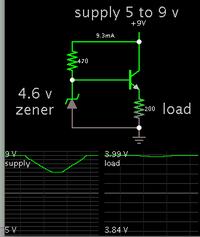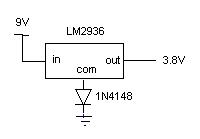dxpwny
Advanced Member level 4
I have a small sealed device that has a USB interface and runs off an internal rechargable battery when not connected to a USB port.
I'd like to add an external 9V battery to extend it's life before a recharge is needed. I attached a 9 V battery to a 78L05, and then the 5 V output to the USB conneector. Made it run nearly twice as long (it uses only about 27 mA).
Only afterwards did I take the time to find out that the device will run with as little as 3.8 V applied. So, by using the 78L05, I was 'wasting' some of the batteries power - the 78L05 would 'shut off' once the battery voltage dropped below about 5V.
So, I'm wondering what would be the most efficient method of attaching a common 9V battery to the USB connector and allow the device to be able to run as long as possible.
I thought of connecting the 9V battery to a LM317 set to output about 3.8V. To make things as efficient as possible, I'd have to make the adjustment resistors a high value to lessen the 'wasted' current ... right ?
Also thought of just using a resistor / zener diode with voltage as close to 3.8 V as I can find. In that case I'd want to use a low value resistor to keep its voltage drop as low as possible ... right ?
Which approach would likely be more efficient ... or is there another possibility I am not seeing ?
I'd like to add an external 9V battery to extend it's life before a recharge is needed. I attached a 9 V battery to a 78L05, and then the 5 V output to the USB conneector. Made it run nearly twice as long (it uses only about 27 mA).
Only afterwards did I take the time to find out that the device will run with as little as 3.8 V applied. So, by using the 78L05, I was 'wasting' some of the batteries power - the 78L05 would 'shut off' once the battery voltage dropped below about 5V.
So, I'm wondering what would be the most efficient method of attaching a common 9V battery to the USB connector and allow the device to be able to run as long as possible.
I thought of connecting the 9V battery to a LM317 set to output about 3.8V. To make things as efficient as possible, I'd have to make the adjustment resistors a high value to lessen the 'wasted' current ... right ?
Also thought of just using a resistor / zener diode with voltage as close to 3.8 V as I can find. In that case I'd want to use a low value resistor to keep its voltage drop as low as possible ... right ?
Which approach would likely be more efficient ... or is there another possibility I am not seeing ?


